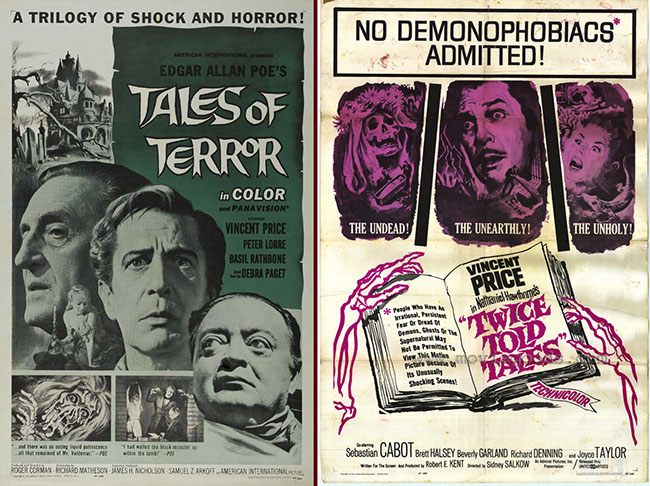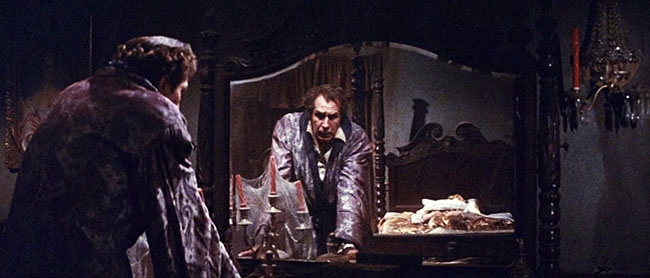
The success of Roger Corman’s House of Usher (aka The Fall of the House of Usher, 1960) for American International spawned a long-running series of films adapted from or inspired by the works of Edgar Allan Poe, and mostly featuring Usher star Vincent Price. Following Pit and the Pendulum (1961) – which established a trend of the plot being only barely related to the Poe original – Corman and Price reunited for Tales of Terror (1962): three Poe short stories brought to the screen with the help of Usher and Pendulum writer Richard Matheson. Matheson, of course, would soon become a genre legend, thanks to his consistently brilliant scripts for The Twilight Zone, his horror novels I Am Legend and Hell House, and so on. But he was also a busy screenwriter willing to meet the demands of an assignment: for an example, check out Fanatic (aka Die! Die! My Darling, 1965), recently released on Blu-Ray for Indicator’s Hammer Volume 1: Fear Warning! box set, for an example of how he could craft an efficient, effective little thriller from modest source material. Matheson has said in interviews that he was not a very big Poe fan, and Usher, too, was just another assignment – but he did take a sketch of a short story and stretch it to feature length in memorable fashion. By the time he was asked to do Tales of Terror, he possibly had an easier job: a Poe anthology, with no story taking up an inordinate amount of time before moving on to the next. The stories were “Morella,” “The Black Cat,” and “The Case of M. Valdemar,” although, in a bit of flourish, he also finds a snug fit for “The Cask of Amontillado.”
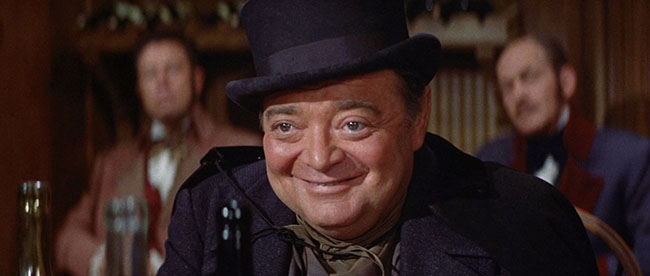
Peter Lorre in the “Black Cat” episode of “Tales of Terror.”
Corman often doesn’t get a fair shake for his talents as a director. He’s given credit for launching the careers of many talented artists, and for his prolific output in a variety of exploitation modes, but his sheer speed, and the quality of his worst films, is too frequently taken as evidence that he wasn’t very good when he was behind the camera. In fact, Corman’s array of experience served him well as director, and if the subject of the film interested him, his curiosity, intelligence, and willingness to experiment produced good films, or at least very interesting ones. (I wouldn’t go to the mat for the merits of his LSD opus The Trip, but the sincerity of the effort, and its avant-garde qualities, make it something I’m always willing to sit down and watch.) Matheson’s playful script for Tales of Terror, which makes room for Gothic horror, dream logic, slapstick, and pitch-black comedy, also allows Corman the opportunity to work in different styles, and he acquits himself nicely. This film, though not the first horror anthology (1945’s Dead of Night casts a long shadow on the subgenre), would nonetheless spawn follow-ups and imitations. The use of macabre comedy, teetering at the edge of camp, and the presence of aging/fading stars from Hollywood’s Golden Age (Peter Lorre and Basil Rathbone join Price here), speak to trends in horror at the time, but all these elements still feel fresh; they would become a little exhausted only later. Corman deserves praise for making an anthology film in which all the segments are strong in their own right, and in different ways – no mean feat.
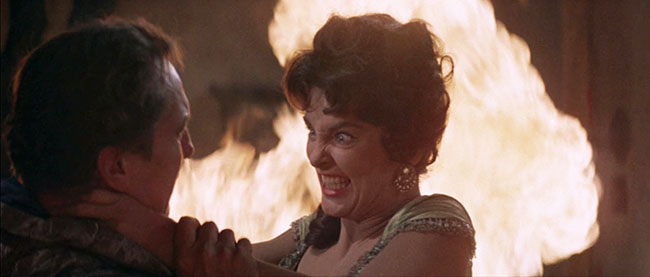
Leona Gage as the vengeful “Morella.”
“Morella” is the most straightforward story, a sort of generic Poe tale, if there is such a thing; it is essentially “The Fall of the House of Usher” with a different twist. Young Lenora (TV actress Maggie Pierce), who is dying from a disease, visits her father (Price) in that same seaside, storm-swept mansion familiar to all Corman fans. The bitter old man still blames his daughter for the death of his wife Morella, who perished giving birth to Lenora. One night the woman in question (Leona Gage) rises from her coffin to swap places with her dying daughter and end her husband in another conflagration – Price’s frequent fate since House of Wax (1953). Most memorable of the three stories is “The Black Cat,” which is actually “The Cask of Amontillado” with the twist ending borrowed from the other tale. Price is Fortunato, a pretentious expert on wine, and Lorre is Montresor, a drunk who successfully challenges his companion’s expertise in a contest. At home, Montresor is trapped in an unhappy (and improbable) marriage to the young, buxom Annabel (Joyce Jameson, The Apartment), whom Fortunato covets; a black cat also lurks about the house. While Fortunato schemes, Montresor patiently arranges his own elaborate counterstrike. Matheson tells the “Amontillado” story faithfully, but borrows the ending from Poe’s “The Black Cat,” allowing Montresor to pay for his crimes with irony. Lorre is completely sympathetic in his role, despite his character’s slurred speech and sad-sack appearance. The segment is such a success that Price, Lorre, Jameson, and writer Matheson would be brought back for what might as well be a reprise in The Comedy of Terrors (1963, with Boris Karloff and Basil Rathbone), directed by the great Jacques Tourneur (Cat People).
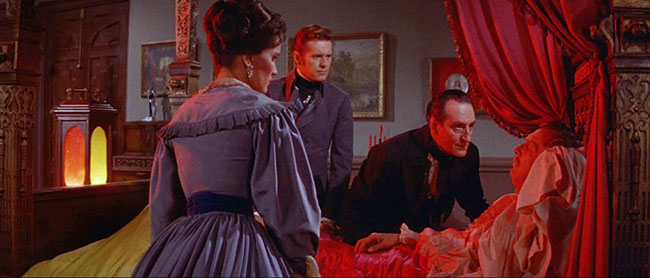
Carmichael (Basil Rathbone) places Valdemar (Vincent Price) under hypnosis.
Tales of Terror‘s finale is “The Case of M. Valdemar,” with Rathbone playing Carmichael, a hypnotist who is asked by Price’s ailing Ernest Valdemar to place him in a hypnotic state at the moment of his demise. When the hour arrives, Carmichael obliges, suspending Valdemar in a twilight state between life and death. Valdemar is immobile in his bed but able to speak, and the suffering he expresses causes his daughter Helene (Debra Paget, The Indian Tomb) to plead with Carmichael to release him from the spell. But now Carmichael reveals his true colors, threatening to keep Valdemar thus unless Helene agrees to marry him. The outrage causes Valdemar to rise as a living corpse and come after Carmichael. Tales of Terror is stitched together by abstract segments of dripping blood with titles and quotes from the Poe texts – a simple but effective approach. Suffice to say, this was one of the films I watched for Halloween this year. For me, Price embodies the holiday more than any other actor, with films like this and William Castle’s House on Haunted Hill (1959). In the AIP pictures, it was often enough to get Price to stand in Gothic mansions draped with cobwebs, holding a candle in his hand while gazing up at dusty portraits of dead lovers and basking in the gorgeous reds and greens of Corman’s quasi-psychedelic lighting (Tales of Terror‘s comes courtesy of DP Floyd Crosby, whose filmography ranges from High Noon to Corman’s Attack of the Crab Monsters). So commercially successful was this formula that others were soon looking to copy it.
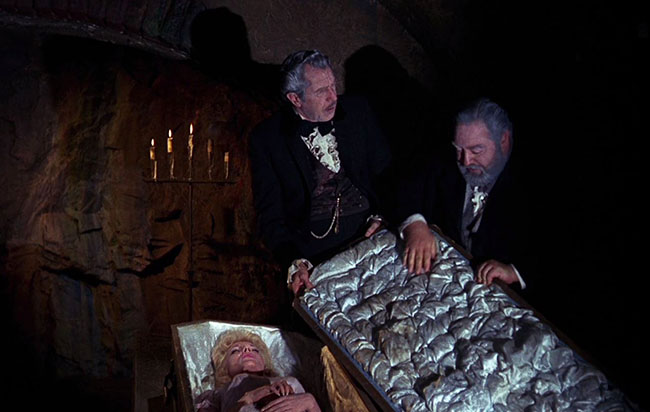
Sebastian Cabot and Price in the segment “Dr. Heidegger’s Experiment” for “Twice Told Tales.”
One of the more blatant imitations was Twice Told Tales (1963), from Robert E. Kent’s Admiral Pictures (which specialized in Westerns) and distributed by United Artists. Price was brought on to star in all three tales of this horror anthology, but the author this time was not Poe but Nathaniel Hawthorne; the title was taken from Hawthorne’s collection of short stories, Twice-Told Tales, though only one of the tales actually originated there. At the helm is journeyman director Sidney Salkow (who would, a year later, reteam with Price for The Last Man on Earth, based on Matheson’s I Am Legend). Hawthorne is a suitable substitute for Poe: they are both permanent fixtures of the American literary canon; they were contemporaries who occasionally corresponded; and their tales often shared a taste for the strange, morbid, or fantastic, though Hawthorne had a tendency to lean more on the allegorical. You’d be forgiven for thinking that the film Twice Told Tales is part of the AIP Poe series for any number of reasons, not least its aesthetic. This is a film in which, at one point, Price is strangled by a skeleton, and skeleton hands feature prominently on the poster against a shocked-looking Price (“The Undead! The Unearthly! The Unholy!” it promises). In these three stories he once more will contend with cobwebs, coffins, ancient manors steeped in legend, and a dose of mad science.
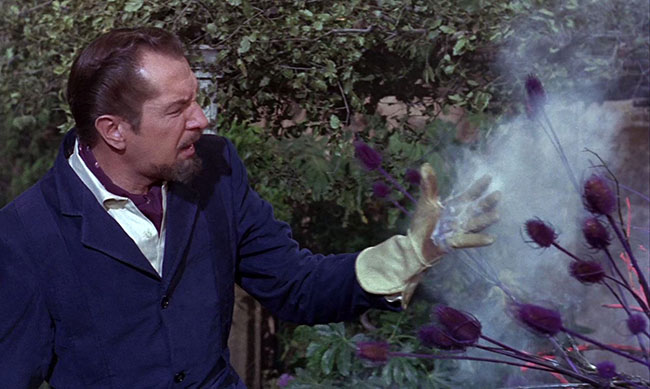
Rappaccini (Price) tests his deadly plants.
Perhaps the most successful of the segments is “Dr. Heidegger’s Experiment,” in which Sebastian Cabot’s Heidegger discovers that his dead wife (Mari Blanchard, McLintock!) has been kept preserved in her mausoleum by a mysterious substance dripping through the earth and into her coffin. He uses this to bring her back to life and to restore his own youth, as well as that of his friend Alex (Price), but revisiting the past only brings to light scandalous, heartbreaking revelations that her death should have put to rest. We also learn that Alex isn’t as good a friend as he’s pretended to be all these years. It’s a tragedy in miniature with excellent performances by Cabot and Price, and also the most Poe-like of the stories. “Rappaccini’s Daughter” casts Price as Dr. Rappaccini, who keeps his daughter Beatrice (Joyce Taylor, Atlantis: The Lost Continent) prisoner in his garden for reasons that will soon become clear. From a distance she develops a love affair with handsome Giovanni (Brett Halsey, who appeared with Price in Return of the Fly), who attempts to learn her father’s secrets. This is both my favorite Hawthorne story and my least favorite adaptation in the film; screenwriter/producer Robert E. Kent makes the mistake of setting Beatrice against her father from the very start, making her so spiteful that she becomes unlikable and sabotages interest in the rest of the story. The final segment is “The House of the Seven Gables,” greatly condensing Hawthorne’s novel. Price had actually appeared in the 1940 adaptation of the book, making this an even more unusual selection for the film. Here, as Gerald Pyncheon, he confronts an old curse upon his family, placed by a rival who believed the land upon which the House of the Seven Gables sits was stolen from him. Corman favorite Beverly Garland (Gunslinger) plays his wife Alice, and the cast also includes Jacqueline deWit (All That Heaven Allows) and Richard Denning (Creature from the Black Lagoon). Though slow to get going, it’s easy to see why this was chosen as the last tale of the film, closing out with another conflagration, an exploding house, and – yes – the iconic sight of Price getting strangled by a skeleton.
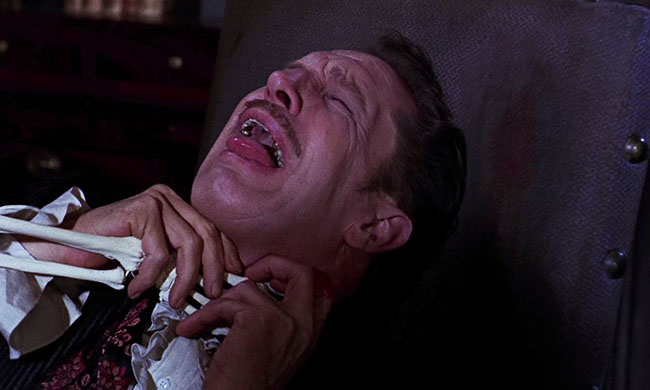
Gerald Pyncheon (Price) confronts his fate in “The House of the Seven Gables.”
Twice Told Tales, though a noble effort to make a classy Gothic horror anthology, is crippled by Robert E. Kent’s decision to adapt three stories over the course of two hours (the film is exactly 120 minutes long). At that length, four or five stories would have been more appropriate – look at what Amicus would soon be accomplishing with their anthologies! Notwithstanding the fact that one of the stories here is actually a novel – or the Reader’s Digest version – there’s really no excuse for this film to have been released without severe cutting. Corman, I’m sure, would have gotten this down to 90 minutes (the better to send it out with a B-picture to fill out the bill). Twice Told Tales, despite a strong start, begins to drag once we get to “Rappaccini’s Daughter,” and the long set-up required for “Seven Gables” doesn’t help either. Visually, the film does not compare to Corman’s lush Tales of Terror, and there’s a stuffiness to the proceedings which even the always-fun Price has a hard time cutting through. It is not a bad film by any stretch of the imagination, but it may have had a tougher time than the Poes convincing kids in the audience that the source material was worth checking out. Back at AIP, Price would soon be making The Haunted Palace (1963) – actually an H.P. Lovecraft adaptation disguised as a Poe – and The Raven (1963), an absolute blast of a picture that sheds the famous poem in favor of a magic battle among Price, Lorre, and Karloff – with Hazel Court and Jack Nicholson trapped in the center. Corman may not have been pleasing the librarians and schoolteachers in the audience, but he knew how to throw a Gothic party.
